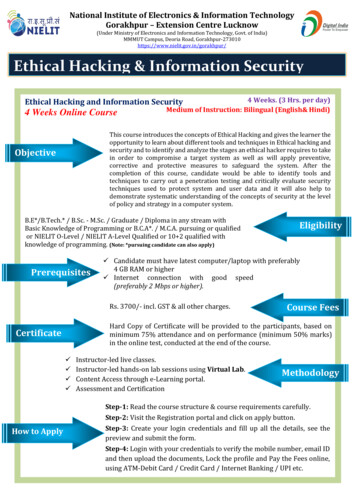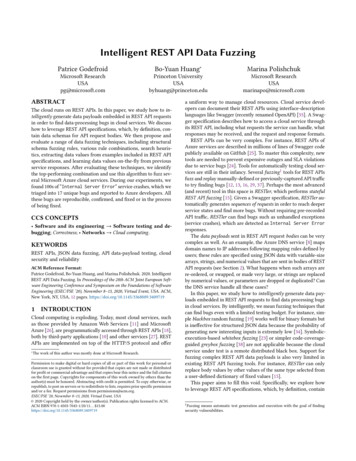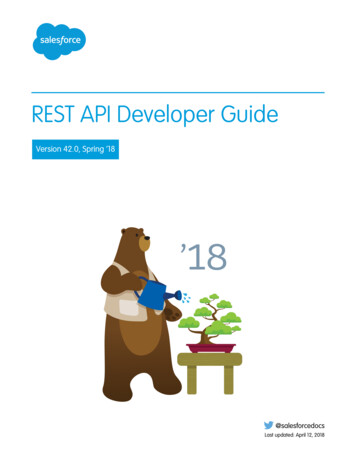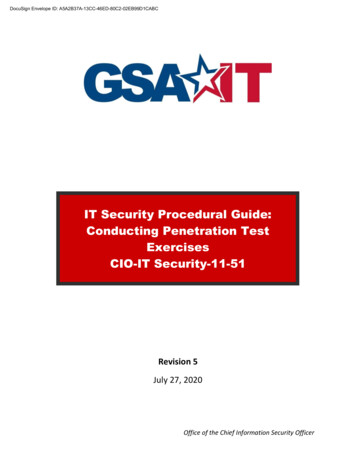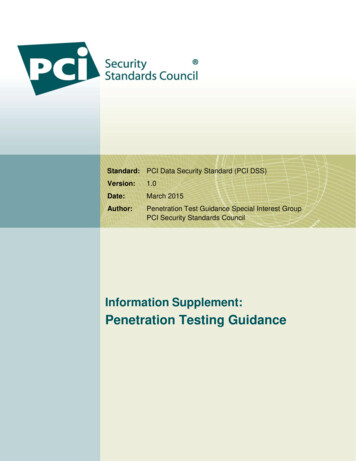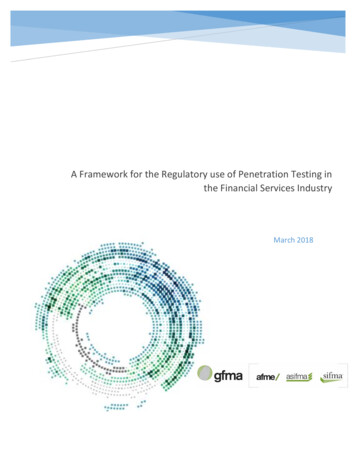![REST API Penetration Testing Report For [CLIENT] - UnderDefense](/img/36/anonymised-api-penetration-testing-report.jpg)
Transcription
REST APIPenetration Testing Reportfor[CLIENT]
Executive summaryThis report presents the results of the “Grey Box” penetration testing for [CLIENT] REST API.The recommendations provided in this report structured to facilitate remediation of theidentified security risks. This document serves as a formal letter of attestation for the recent[CLIENT] Grey Box REST API Penetration Testing.Evaluation ratings compare information gathered during the course of the engagement to “bestin class” criteria for security standards. We believe that the statements made in this documentprovide an accurate assessment of [CLIENT] current security as it relates to Web APIperimeter.We highly recommend to review section of Summary of business risks and High-LevelRecommendations for better understanding of risks and discovered security issues.ScopeSecuritylevelWeb API perimeterGoodGradeBUnderDefense Grading Criteria:GradeSecurityCriteria DescriptionAExcellentThe security exceeds “Industry Best Practice” standards. The overallposture was found to be excellent with only a few low-risk findingsidentified.BGoodThe security meets with accepted standards for “Industry BestPractice.” The overall posture was found to be strong with only ahandful of medium- and low- risk shortcomings identified.CFairCurrent solutions protect some areas of the enterprise from securityissues. Moderate changes are required to elevate the discussed areasto “Industry Best Practice” standardsDPoorSignificant security deficiencies exist. Immediate attention should begiven to the discussed issues to address exposures identified. Majorchanges are required to elevate to “Industry Best Practice” standards.FInadequateSerious security deficiencies exist. Shortcomings were identifiedthroughout most or even all of the security controls examined.Improving security will require a major allocation of resources.ConfidentialAPI Penetration Testing Report for [CLIENT]1Revised 15.03.2019
Assumptions & ConstraintsAs the environment changes, and new vulnerabilities and risks are discovered and madepublic, an organization’s overall security posture will change. Such changes may affect thevalidity of this letter. Therefore, the conclusion reached from our analysis only represents a“snapshot” in time.Objectives & ScopeOrganization[CLIENT ORGANIZATION]Audit typeGray Box REST API Penetration Testing Asset URLAudit b. 25 - Mar. 15, 2019Consultants performed discovery process to gather information about the target and searchedfor information disclosure vulnerabilities. With this data in hand, we conducted the bulk of thetesting manually, which consisted of input validation tests, impersonation (authentication andauthorization) tests, and session state management tests. The purpose of this penetrationtesting is to illuminate security risks by leveraging weaknesses within the environment that leadto the obtainment of unauthorized access and/or the retrieval of sensitive information. Theshortcomings identified during the assessment were used to formulate recommendations andmitigation strategies for improving the overall security posture.Results OverviewThe test uncovered a few vulnerabilities that may cause sensitive data leakage, brokenconfidentiality and integrity and availability of the resource.Identified vulnerabilities are easily exploitable and the risk posed by these vulnerabilities cancause damage to the application and company.ConfidentialAPI Penetration Testing Report for [CLIENT]2Revised 15.03.2019
Security experts performed manual security testing according to OWASP Web ApplicationTesting Methodology, which demonstrate the following results.Severity# of issuesCriticalHighMediumLowInformationa l00391Severity scoring: Critical - Immediate threat to key business processes.High – Direct threat to key business processes.Medium – Indirect threat to key business processes or partial threat to businessprocesses.Low – No direct threat exists. Vulnerability may be exploited using other vulnerabilities.Informational – This finding does not indicate vulnerability, but states a comment thatnotifies about design flaws and improper implementation that might cause a problem inthe long run.ConfidentialAPI Penetration Testing Report for [CLIENT]3Revised 15.03.2019
Summary of business risksMedium and low severity issues can lead to: Attacks on communication channels and as a result on sensitive data leakage andpossible modification, in other words it affects the integrity and confidentiality of datatransferred.Information leakage about system components which may be used by attackers forfurther malicious actions.Attacks on old and not patched system components with bunch of publicly knownvulnerabilities.Enumerating existing users emails/usernames and brute forcing their passwords. Easyaccess to their session after exploitation of high level risks.Combination of few issues can be used for successful realisation of attacks.Informational severity issues do not carry direct threat but they can be used to gather usefulinformation for an attacker.High-Level RecommendationsTaking into consideration all issues that have been discovered, we highly recommend to: Conduct current vs. future IT/Security program reviewConduct Static code analysis for codebaseEstablish Secure SDLC best practices, assign Security Engineer to a project to monthlyreview code, conduct SAST & DAST security testingReview Architecture of applicationDeploy Web Application Firewall solution to detect any malicious manipulationsContinuously monitor logs for anomalies to detect abnormal behaviour and fraudtransactions. Dedicate security operations engineer to this taskImplement Patch Management procedures for whole IT infrastructure and endpoints ofemployees and developersContinuously Patch production and development environments and systems on regularbases with latest releases and security updatesConduct annual Penetration test and quarterly Vulnerability Scanning against internaland external environmentDevelop and Conduct Security Awareness training for employees and developersDevelop Incident Response Plan in case of Data breach or security incidentsAnalyse risks for key assets and resourcesUpdate codebase to conduct verification and sanitization of user input on both, clientand server sideUse only encrypted channels for communicationsDo not send any unnecessary data in requests and cookiesImprove server and application configuration to meet security best practisesConfidentialAPI Penetration Testing Report for [CLIENT]4Revised 15.03.2019
Performed tests All set of applicable OWASP Top 10 Security ThreatsAll set of applicable SANS 25 Security ThreatsCriteria LabelA1:2017-InjectionStatusMeets criteriaA2:2017-Broken AuthenticationFails criteriaA3:2017-Sensitive Data ExposureFails criteriaA4:2017-XL External Entities (XXE)Meets criteriaA5:2017-Broken Access ControlMeets criteriaA6:2017-Security MisconfigurationFails criteriaA7:2017-Cross-Site Scripting (XSS)Fails criteriaA8:2017-Insecure DeserializationA9:2017-Using Components with Known VulnerabilitiesA10:2017-Insufficient Logging&MonitoringMeets criteriaFails criteriaN/ASecurity tools used Burp Suite Pro [Commercial Edition]NmapTestSSLSQLmapDifferent Burp Suite plugins (Joseph, etc.)Project limitationsThe Grey Box assessment was conducted against production environment with all limitations, itprovides.ConfidentialAPI Penetration Testing Report for [CLIENT]5Revised 15.03.2019
MethodologyOur Penetration Testing Methodology grounded on following guides and standards: Penetration Testing Execution StandardOWASP Top 10 Application Security Risks - 2017OWASP Testing GuideOWASP ASVSOpen Web Application Security Project (OWASP) is an industry initiative for web applicationsecurity. OWASP has identified the 10 most common attacks that succeed against webapplications. These comprise the OWASP Top 10.Application penetration test includes all the items in the OWASP Top 10 and more. Thepenetration tester remotely tries to compromise the OWASP Top 10 flaws. The flaws listed byOWASP in its most recent Top 10 and the status of the application against those are depicted inthe table below.ConfidentialAPI Penetration Testing Report for [CLIENT]6Revised 15.03.2019
Findings DetailsUser enumerationSEVERITY: MediumLOCATION: /api/v1/ge/forgottenpasswordsISSUE DESCRIPTION:User enumeration is when a malicious actor can use brute-force to either guess or confirmvalid users in a system. User enumeration is often a web application vulnerability, though it canalso be found in any system that requires user authentication. Two of the most common areaswhere user enumeration occurs are in a site's login page and its ‘Forgot Password' functionality.We have been able to find user enumeration vulnerability on ‘Sign Up’, and ‘Forgot Password’functionality which allows attackers to enumerate existing users.PROOF OF VULNERABILITY:User enumeration over forgottenpasswords API call on: e4.comRequest:POST /api/v1/ge/forgottenpasswords HTTP/1.1marketCode: enContent-Type: application/jsonUser-Agent: Mozilla/5.0 (iPhone; CPU iPhone OS 9 1 like Mac OS X) AppleWebKit/601.1.46(KHTML, like Gecko) Version/9.0 Mobile/13B143 Safari/601.1cache-control: no-cacheAccept: */*Host: m.example2.comAccept-Encoding: gzip, deflateContent-Length: 140Connection: close{ Identifier": "hacker1" ,""ResetType": "SMS","NationalId": "0as9aa0d596697","PhoneExtension": " 380",ConfidentialAPI Penetration Testing Report for [CLIENT]7Revised 15.03.2019
"PhoneNumber": "2213"}If user exists we receive RESPONSE:{"code":"E FORGOTTENPASSWORDS INVALIDCREDENTIALS"}User enumeration on www.example7.com in /en/api/Authentication/Login API call (out ofscope item):If password is invalid response looks like:HTTP/1.1 200 OKCache-Control: no-cache,no-store, no-cache, must-revalidate, post-check 0, pre-check 0.{"Success":false,"Message":" InvalidCredentials c","LastLoginDate":null,"StatusCode":401}If username is invalid response looks like:HTTP/1.1 200 OKCache-Control: no-cache,no-store, no-cache, must-revalidate, post-check 0, pre-check 0.{"Success":false,"Message":" UserStatusUnknown ATIONS :Provide less verbose responses in the functionality. The server should return the same genericmessages regardless if the username/email address exists or not. A message such as ‘Furtherinstructions have been sent to your email address’ or similar. For more detailed informationplease consider using the link r-enumeration/ConfidentialAPI Penetration Testing Report for [CLIENT]8Revised 15.03.2019
Session token in local storageSEVERITY: MediumLOCATION: mhtps://www.m.example5.co.ukISSUE DESCRIPTION:A JWT needs to be stored in a safe place inside the user's browser. If you store it insidelocalStorage, it's accessible by any script inside your page (which is as bad as it sounds as anXSS attack can let an external attacker get access to the token).PROOF OF VULNERABILITY:Session token in local storage:RECOMMENDATIONS :Don't store session token in local storage (or session storage). If any of the 3rd part scripts youinclude in your page gets compromised, it can access all your users' tokens.ConfidentialAPI Penetration Testing Report for [CLIENT]9Revised 15.03.2019
Data ValidationSEVERITY: MediumLOCATION: /api/v1/customerregistrationtokensISSUE DESCRIPTION:The most common web application security weakness is the failure to properly validate inputfrom the client or environment. This weakness leads to almost all of the major vulnerabilities inapplications, such as Interpreter Injection , locale/Unicode attacks, file system attacks andbuffer overflows. Data from the client should never be trusted for the client has everypossibility to tamper with the data.In many cases, Encoding has the potential to defuse attacks that rely on lack of input validation.For example, if you use HTML entity encoding on user input before it is sent to a browser, it willprevent most XSS attacks. However, simply preventing attacks is not enough - you mustperform Intrusion Detection in your applications. Otherwise, you are allowing attackers torepeatedly attack your application until they find a vulnerability that you haven't protectedagainst. Detecting attempts to find these weaknesses is a critical protection mechanism.PROOF OF VULNERABILITY:We are able to insert any data to fields as city, Zip code, street while registering/editingaccounts.ConfidentialAPI Penetration Testing Report for [CLIENT]10Revised 15.03.2019
Request ress":{"street":" Qwe ","zipCode":" code "email":"attacker@example.com","password":" Weak6c ,"email":"attacker@example.com","phoneExtension":" 380","phoneNumber":" 33212222 /1.1 202 12c59 "}RECOMMENDATIONS :Every user input field should be validated both on front end and back /master/cheatsheets/Input Validation Cheat Sheet.mdConfidentialAPI Penetration Testing Report for [CLIENT]11Revised 15.03.2019
Possible BREACH vulnerabilitySEVERITY: LowLOCATION: m.example5.co.ukISSUE DESCRIPTION:This web application is potentially vulnerable to the BREACH attack.An attacker with the ability to: Inject partial chosen plaintext into a victim's requestsMeasure the size of encrypted trafficcan leverage information leaked by compression to recover targeted parts of theplaintext.BREACH (Browser Reconnaissance & Exfiltration via Adaptive Compression of Hypertext) is acategory of vulnerabilities and not a specific instance affecting a specific piece of software.To be vulnerable, a web application must: Be served from a server that uses HTTP-level compressionReflect user-input in HTTP response bodiesReflect a secret (such as a CSRF token) in HTTP response bodiesPROOF OF VULNERABILITY:TestSSL results. Testing vulnerabilities.CRIME, TLS (CVE-2012-4929)not vulnerable (OK) BREACH (CVE-2013-3587) potentially NOT ok , uses gzip HTTP compression.- only supplied "/" tested Can be ignored for static pages or if no secrets in the page.RECOMMENDATIONS :The mitigations are ordered by effectiveness (not by their practicality - as this may differ fromone application to another). Disabling HTTP compressionSeparating secrets from user inputRandomizing secrets per requestMasking secrets (effectively randomizing by XORing with a random secret per request)Protecting vulnerable pages with CSRFLength hiding (by adding random number of bytes to the responses)Rate-limiting the requestsConfidentialAPI Penetration Testing Report for [CLIENT]12Revised 15.03.2019
Possible BEAST vulnerabilitySEVERITY: LowLOCATION: ple2.comm.example3.comISSUE DESCRIPTION:The SSL protocol, as used in certain configurations in Microsoft Windows and MicrosoftInternet Explorer, Mozilla Firefox, Google Chrome, Opera, and other products, encrypts data byusing CBC mode with chained initialization vectors, which allows man-in-the-middle attackersto obtain plaintext HTTP headers via a blockwise chosen-boundary attack (BCBA) on an HTTPSsession, in conjunction with JavaScript code that uses (1) the HTML5 WebSocket API, (2) theJava URLConnection API, or (3) the Silverlight WebClient API, aka a "BEAST" attack.PROOF OF VULNERABILITY:TestSSL results.Testing vulnerabilities.LOGJAM (CVE-2015-4000), experimentalDH key detectedBEAST (CVE-2011-3389) protocols not vulnerable (OK): no DH EXPORT ciphers, no TLS1: ECDHE-RSA-AES128-SHAECDHE-RSA-AES256-SHAAES128-SHA AES256-SHA VULNERABLE -- but also supports higherTLSv1.1 TLSv1.2 (likely mitigated).RECOMMENDATIONS :Disable TLS 1.0 and have users connect using TLS 1.1 or TLS 1.2 protocols which are immune tothe BEAST attack. TLS 1.0 is now considered insecure and disabling the protocol improves theoverall security.REFERENCE pher-hardeningConfidentialAPI Penetration Testing Report for [CLIENT]13Revised 15.03.2019
Possible LUCKY13 vulnerabilitySEVERITY: LowLOCATION: m.example5.co.ukm.example4.com m.example1.com m.example2.com m.example3.comISSUE DESCRIPTION:The TLS protocol 1.1 and 1.2 and the DTLS protocol 1.0 and 1.2, as used in OpenSSL, OpenJDK,PolarSSL, and other products, do not properly consider timing side-channel attacks on a MACcheck requirement during the processing of malformed CBC padding, which allows remoteattackers to conduct distinguishing attacks and plaintext-recovery attacks via statistical analysisof timing data for crafted packets, aka the "Lucky Thirteen" issue.PROOF OF VULNERABILITY:TestSSL results.Testing vulnerabilities.BEAST (CVE-2011-3389)TLS1: ECDHE-RSA-AES128-SHAECDHE-RSA-AES256-SHAAES128-SHA AES256-SHAVULNERABLE -- but also supports higherprotocols TLSv1.1 TLSv1.2 (likely mitigated)LUCKY13 (CVE-2013-0169) , experimental potentially VULNERABLE , uses cipher blockchaining (CBC) ciphers with TLS. Check patchesRC4 (CVE-2013-2566, CVE-2015-2808)no RC4 ciphers detected (OK).RECOMMENDATIONS :Avoid using TLS in CBC-mode and to switch to using AEAD algorithms.REFERENCE es-cloudflare-users-prot/ConfidentialAPI Penetration Testing Report for [CLIENT]14Revised 15.03.2019
ClickjackingSEVERITY: LowLOCATION: ple2.comm.example3.comISSUE DESCRIPTION:Clickjacking, also known as a "UI redress attack", is when an attacker uses multiple transparentor opaque layers to trick a user into clicking on a button or link on another page when theywere intending to click on the top level page. Thus, the attacker is "hijacking" clicks meant fortheir page and routing them to another page, most likely owned by another application,domain, or both.PROOF OF VULNERABILITY:Html code which creates iframe of the website. html head title Clickjack test page /title /head body p Website is vulnerable to clickjacking! /p iframe src "https://example1.com/" width "600" height "300" /iframe /body /html ConfidentialAPI Penetration Testing Report for [CLIENT]15Revised 15.03.2019
As a result it’s possible to create iframe of the website.RECOMMENDATIONS:There are two main ways to prevent clickjacking: Sending the proper Content Security Policy (CSP) frame-ancestors directive responseheaders that instruct the browser to not allow framing from other domains. (Thisreplaces the older X-Frame-Options HTTP headers.)Employing defensive code in the UI to ensure that the current frame is the most toplevel window.REFERENCE :https://www.owasp.org/index.php/Clickjacking Defense Cheat SheetConfidentialAPI Penetration Testing Report for [CLIENT]16Revised 15.03.2019
: LowLOCATION: omain.example6.com/wp-json/ (out of scope)ISSUE DESCRIPTION:When new vulnerabilities are discovered in software, it’s important to apply patches andupdate to a version of the software for which the vulnerability is fixed. Attackers can useknown vulnerabilities, so security patches should be deployed as soon as they are available.We have been able to find outdated version of Angular and Nginx services which are exposedfor several known vulnerabilities.PROOF OF VULNERABILITY:Vulnerability in lnerability in Lodash and Angular onfidentialAPI Penetration Testing Report for [CLIENT]17Revised 15.03.2019
Vulnerable Apache st/vendor id-45/product id-66/version TIONS :Update outdated software and always keep it up-to-date in order to avoid the threat of knownvulnerabilities.Insufficient Brute-force protectionSEVERITY: LowLOCATION: m.example1.comISSUE DESCRIPTION:A system administrator uses a weak and guessable password which is easy to bruteforce andgain control over administration functionality. Obvious and easy to remember passwords canalso be brute forced easily.There is no Brute-force protection mechanism on login page. Attackers can easily providebrute-force attack to gain access to administrative console.ConfidentialAPI Penetration Testing Report for [CLIENT]18Revised 15.03.2019
RECOMMENDATIONS :We strongly recommend to use long passwords that can’t be guessed easily.It is recommended to use a challenge-response test to prevent automated submissions of thelogin page. Tools such as the free reCAPTCHA can be used to require the user to enter a wordor solve a simple math problem to ensure the user is, in fact, a person.Other way progressive delays technique may be used. With progressive delays, user accountsare locked out for a set period of time after a few failed login attempts. The lock-out timeincreases with each subsequent failed attempt. This prevents automated tools from performinga brute force attack and effectively makes it impractical to perform such an attack.Weak Lock out mechanismSEVERITY: LowLOCATION: /api/v1/single-sign-on-sessions/ISSUE DESCRIPTION:Account lockout mechanisms are used to mitigate brute force password guessing attacks.Accounts are typically locked after 3 to 5 unsuccessful login attempts and can only be unlockedafter a predetermined period of time, via a Customer Support service or intervention by anadministrator. Account lockout mechanisms require a balance between protecting accountsfrom unauthorized access and protecting users from being denied authorized access.PROOF OF VULNERABILITY:User account locked after 5 login attempts.ConfidentialAPI Penetration Testing Report for [CLIENT]19Revised 15.03.2019
RECOMMENDATIONS :Apply account unlock mechanisms depending on the risk level. In order from lowest to highestassurance: Time-based lockout and unlock.Self-service unlock (sends unlock email to registered email address).Manual administrator unlock.Manual administrator unlock with positive user identification.Weak password policySEVERITY: LowLOCATION: /en/open-account?product common/api/v1/customerregistrationtokensISSUE DESCRIPTION:The most common web application security weakness is the failure to properly validate inputfrom the client or environment. This weakness leads to almost all of the major vulnerabilities inapplications, such as Interpreter Injection , locale/Unicode attacks, file system attacks andbuffer overflows. Data from the client should never be trusted for the client has everypossibility to tamper with the data.In many cases, Encoding has the potential to defuse attacks that rely on lack of inputvalidation. For example, if you use HTML entity encoding on user input before it is sent to abrowser, it will prevent most XSS attacks. However, simply preventing attacks is not enough you must perform Intrusion Detection in your applications. Otherwise, you are allowingattackers to repeatedly attack your application until they find a vulnerability that you haven'tprotected against. Detecting attempts to find these weaknesses is a critical protectionmechanism.ConfidentialAPI Penetration Testing Report for [CLIENT]20Revised 15.03.2019
PROOF OF VULNERABILITY:RECOMMENDATIONS :According to OWASP Application Security Verification Standard, passwords should match nextcriterias: User set passwords must be at least 12 characters in length.Unicode characters must be permitted in passwords.Password shouldn’t have composition rules limiting the type of characters permitted.Also, according to NIST 800-63, passwords, called “Memorized Secrets”, shouldn’t be: Passwords obtained from previous breach corpuses.Dictionary words.Repetitive or sequential characters (e.g. ‘aaaaaa’, ‘1234abcd’).Context-specific words, such as the name of the service, the username, and derivativesthereof.ConfidentialAPI Penetration Testing Report for [CLIENT]21Revised 15.03.2019
Reflected XSS in url addressSEVERITY: LowLOCATION: subdomain.example7.com/download/de/?'"" " body div script alert(1) /script /subdomain.example6.com/download/de/?'"" " body div script alert(1) /script /ISSUE DESCRIPTION:Cross-Site Scripting (XSS) attacks are a type of injection, in which malicious scripts are injectedinto otherwise benign and trusted websites. XSS attacks occur when an attacker uses a webapplication to send malicious code, generally in the form of a browser side script, to a differentend user. Flaws that allow these attacks to succeed are quite widespread and occur anywherea web application uses input from a user in the output it generates without validating orencoding it.Reflected attacks are those where the injected script is reflected off the web server, such as inan error message, search result, or any other response that includes some or all of the inputsent to the server as part of the request. Reflected attacks are delivered to victims via anotherroute, such as in an email message, or on some other website. When a user is tricked intoclicking on a malicious link, submitting a specially crafted form, or even just browsing to amalicious site, the injected code travels to the vulnerable web site, which reflects the attackback to the user’s browser. The browser then executes the code because it came from a"trusted" server.PROOF OF VULNERABILITY:RequestGET/download/de/? '"" " body div script alert(localStorage.getItem('authReducer') /script /div img%20src 'x'%20onerror "alert(1) /body HTTP/1.1Host: subdomain.example6.comUser-Agent: Mozilla/5.0 (Macintosh; Intel Mac OS X 10.14; rv:65.0) Gecko/20100101Firefox/65.0Accept: text/html,application/xhtml xml,application/xml;q 0.9,image/webp,*/*;q 0.8Accept-Language: en-US,en;q 0.5Accept-Encoding: gzip, deflateConnection: closeResponse. !-- Open Graph -- meta property "og:title" content ""/ meta property "og:type"content "website"/ meta property "og:url"content "https://subdomain.example6.com/download/de/?'"" " body div script alert(localStorage.getItem('authReducer') /script /div img%20src 'x'%20onerror "alert(1) /body "/ .ConfidentialAPI Penetration Testing Report for [CLIENT]22Revised 15.03.2019
RECOMMENDATIONS :Use verification and sanitization on both client and server side, For more detailed information,please see the link below:https://www.owasp.org/index.php/XSS (Cross Site Scripting) Prevention Cheat SheetInformative Error MessagesSEVERITY: InformationalLOCATION: n.example6.com/wp-jsonISSUE DESCRIPTION:During a penetration testing, we come up against some error codes generated fromapplications or web servers. It's possible to cause these errors to be displayed by using aparticular requests, either specially crafted with tools or created manually. These errorscontaining information about server and it’s version .Such information is very useful for hackers during their activities, because they reveal a lot ofinformation about databases, bugs, and other components directly linked with webapplications.Do not expose sensitive information in error messages and server headers. Any system internalinformation should be hidden from the user.PROOF OF VULNERABILITY:It's possible to cause these errors to be displayed by using a particular requests, either speciallyConfidentialAPI Penetration Testing Report for [CLIENT]23Revised 15.03.2019
crafted with tools or created manually.RequestPOST /api/v1/customerregistrationtokens HTTP/1.1Host: ":"attacker@example.com","phoneExtension":" eredFromProduct":"common"}}ResponseHTTP/1.1 415 Unsupported Media TypeCache-Control: no-cache.{"message": "The request contains an entity body but no Content-Type header. Theinferred media type 'application/octet-stream' is not supported for this resource.","exceptionMessage": "No MediaTypeFormatter is available to read an object of type'MgaRegistrationRequest' from content with media type 'application/octet-stream'.","exceptionType": " System.Net.Http.UnsupportedMediaTypeException ","stackTrace": "at T](HttpContentcontent, Type type, IEnumerable 1 formatters, IFormatterLogger formatterLogger,CancellationToken cancellationToken)\r\natSystem.We
OWASP Testing Guide OWASP ASVS Open Web Application Security Project (OWASP) is an industry initiative for web application security. OWASP has identified the 1 0 most common attacks that succeed against web applications. These comprise the OWASP Top 10.

